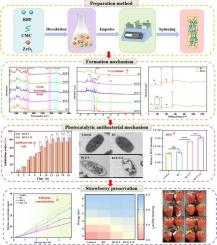利用微流体技术生产的光催化米糠蛋白/羧甲基纤维素/ZrO2 纤维:形成机制、抑菌和草莓保鲜
IF 5.4
2区 医学
Q2 MATERIALS SCIENCE, BIOMATERIALS
引用次数: 0
摘要
开发具有成本效益和环境可持续性的活性包装材料仍然是一项重要挑战。我们利用微流体纺丝技术开发了基于米糠蛋白(RBP)的纤维,其中包含羧甲基纤维素(CMC)和 ZrO2 纳米粒子(ZrO2 NPs,0 %-7 %,m/m)。RBP、CMC 和 ZrO2 NPs 的结合形成了强大的氢键网络,增强了纤维的热稳定性和结晶性,降低了表面疏水性,并使分子取向一致。在可见光(300 W,12 h)的催化下,纤维中的 ZrO2 NPs 产生活性氧,抑制枯草芽孢杆菌的氧化应激抵抗系统,破坏其生物膜和 DNA,从而显示出卓越的抗菌效果。此外,在贮藏过程中,这种纤维还能清除乙烯,从而降低草莓亮度、硬度和重量的损失率。这项研究为米糠副产品中的 RBP 纤维在食品保鲜、抗菌和增值利用方面提供了新的思路。本文章由计算机程序翻译,如有差异,请以英文原文为准。

Photocatalytic rice bran protein/carboxymethyl cellulose/ZrO2 fiber produced by microfluidics: Formation mechanism, bacteriostasis and strawberry preservation
Developing cost-effective and environmentally sustainable active packaging materials remains an important challenge. We have developed rice bran protein (RBP)-based fibers incorporating carboxymethyl cellulose (CMC) and ZrO2 nanoparticles (ZrO2 NPs, 0 %–7 %, m/m) using microfluidic spinning. The integration of RBP, CMC, and ZrO2 NPs formed a robust hydrogen bond network that enhanced the fibers' thermal stability and crystallinity, reduced surface hydrophobicity, and aligned the molecular orientation. Under the catalysis of visible light (300 W, 12 h), ZrO2 NPs in the fiber produced reactive oxygen species, which inhibited the oxidative stress resistance system of Bacillus subtilis and destroyed its biofilm and DNA, thus showing excellent antibacterial effect. Additionally, during storage, this fiber also showed the ability to scavenge ethylene, thereby reducing the rate of loss of luminance, hardness and weight of strawberries. This study offers a new idea for RBP fiber in food preservation, antibacterial, and value-added utilization of rice bran by-products.
求助全文
通过发布文献求助,成功后即可免费获取论文全文。
去求助
来源期刊

ACS Biomaterials Science & Engineering
Materials Science-Biomaterials
CiteScore
10.30
自引率
3.40%
发文量
413
期刊介绍:
ACS Biomaterials Science & Engineering is the leading journal in the field of biomaterials, serving as an international forum for publishing cutting-edge research and innovative ideas on a broad range of topics:
Applications and Health – implantable tissues and devices, prosthesis, health risks, toxicology
Bio-interactions and Bio-compatibility – material-biology interactions, chemical/morphological/structural communication, mechanobiology, signaling and biological responses, immuno-engineering, calcification, coatings, corrosion and degradation of biomaterials and devices, biophysical regulation of cell functions
Characterization, Synthesis, and Modification – new biomaterials, bioinspired and biomimetic approaches to biomaterials, exploiting structural hierarchy and architectural control, combinatorial strategies for biomaterials discovery, genetic biomaterials design, synthetic biology, new composite systems, bionics, polymer synthesis
Controlled Release and Delivery Systems – biomaterial-based drug and gene delivery, bio-responsive delivery of regulatory molecules, pharmaceutical engineering
Healthcare Advances – clinical translation, regulatory issues, patient safety, emerging trends
Imaging and Diagnostics – imaging agents and probes, theranostics, biosensors, monitoring
Manufacturing and Technology – 3D printing, inks, organ-on-a-chip, bioreactor/perfusion systems, microdevices, BioMEMS, optics and electronics interfaces with biomaterials, systems integration
Modeling and Informatics Tools – scaling methods to guide biomaterial design, predictive algorithms for structure-function, biomechanics, integrating bioinformatics with biomaterials discovery, metabolomics in the context of biomaterials
Tissue Engineering and Regenerative Medicine – basic and applied studies, cell therapies, scaffolds, vascularization, bioartificial organs, transplantation and functionality, cellular agriculture
 求助内容:
求助内容: 应助结果提醒方式:
应助结果提醒方式:


